You are here: Foswiki>Gunwiki Web>AnalysisMagpulPmagWindow (01 Sep 2011, SeanNewton)Edit Attach
Analysis of a Magpul Windowed Pmag
This is part of the STANAG Magazine Comparison series. Magpul, best known for its durable polymer AR-15 accessories, introduced the P-Mag (P for Polymer, presumably) some time ago. The latest iteration is the windowed P-Mag, which has a transparent line on the right side through which you may view the ammunition remaining in the magazine.Parts Compatibility
While the rest of the parts will not interchange with other magazines, the spring will interchange with a standard USGI magazine spring. This is all that is required to rebuild a lawfully held USGI magazine into a Pmag in California.Analysis
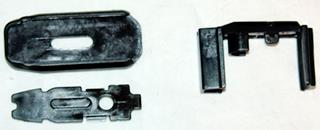 All of the smaller components. To the right is the follower, which is a very effective anti-tilt design will not fit into other magazines because it's designed for the specially shaped Pmag bodies. To the left is the floorplate assembly, which is in two pieces - on top is the base plate of the magazine, and below is the piece which the spring connects to. Note the oval hole in the base plate and the matching notch in the other piece. The connection between these two pieces is secure without being difficult to remove.
All of the smaller components. To the right is the follower, which is a very effective anti-tilt design will not fit into other magazines because it's designed for the specially shaped Pmag bodies. To the left is the floorplate assembly, which is in two pieces - on top is the base plate of the magazine, and below is the piece which the spring connects to. Note the oval hole in the base plate and the matching notch in the other piece. The connection between these two pieces is secure without being difficult to remove.
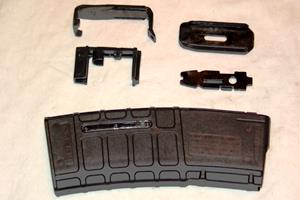 All the parts of the pmag except for the spring. At top left is the dust cover which each pmag comes with. This fits on top of the magazine body, and serves to keep dust and moisture out of the magazine. Immediately below it is the follower, which has both a curved section to trap the top of the magazine spring and a hole to thread the spring through. Also visible is a transparent strip of plastic on the pmag body (bottom part), which is the window the magazines were named after. Notice that the magazine does not go all the way to the top, as a significant part of the magazine is inside of the rifle when in use.
All the parts of the pmag except for the spring. At top left is the dust cover which each pmag comes with. This fits on top of the magazine body, and serves to keep dust and moisture out of the magazine. Immediately below it is the follower, which has both a curved section to trap the top of the magazine spring and a hole to thread the spring through. Also visible is a transparent strip of plastic on the pmag body (bottom part), which is the window the magazines were named after. Notice that the magazine does not go all the way to the top, as a significant part of the magazine is inside of the rifle when in use.
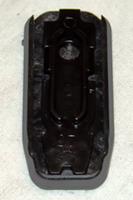 The two halves of the floorplate assembly nested together. Note that they appear to be made of two different plastics. Also note the protrusion on the top piece. This is contoured so that it traps the magazine spring.
The two halves of the floorplate assembly nested together. Note that they appear to be made of two different plastics. Also note the protrusion on the top piece. This is contoured so that it traps the magazine spring.
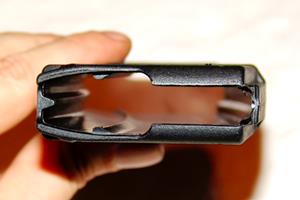 A view down the top of a Pmag. Note the curvature - this is why so few of the parts from other magazines will interchange with it. Also note that there's a few rough patches where the plastic wasn't fully deburred (right side, inside), but this is strictly a cosmetic issue and should not impede function.
A view down the top of a Pmag. Note the curvature - this is why so few of the parts from other magazines will interchange with it. Also note that there's a few rough patches where the plastic wasn't fully deburred (right side, inside), but this is strictly a cosmetic issue and should not impede function.
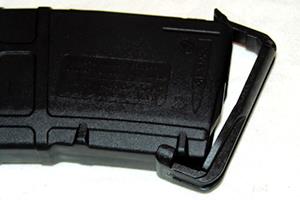 Clipping the dust cover over the top of the magazine. Note that the front of the dust cover hooks into a groove in the front of the mag, and then hinges on towards the rear.
Clipping the dust cover over the top of the magazine. Note that the front of the dust cover hooks into a groove in the front of the mag, and then hinges on towards the rear.
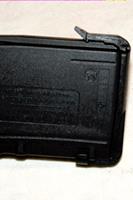 The dust cover, installed. As you can see, it's a very solid fit and should keep just about any dust out of the magazine.
The dust cover, installed. As you can see, it's a very solid fit and should keep just about any dust out of the magazine.
-- SeanNewton - 09 Jun 2011
Edit | Attach | Print version | History: r3 < r2 < r1 | Backlinks | View wiki text | Edit wiki text | More topic actions
Topic revision: r3 - 01 Sep 2011, SeanNewton
%META:TOPICINFO{author="ProjectContributor" date="1231502400" format="1.1" version="1"}%
 Copyright © by the contributing authors. All material on this collaboration platform is the property of the contributing authors.
Copyright © by the contributing authors. All material on this collaboration platform is the property of the contributing authors. Ideas, requests, problems regarding Foswiki? Send feedback
